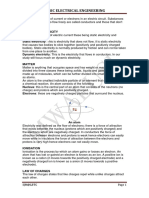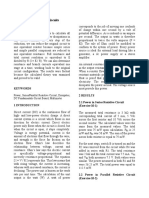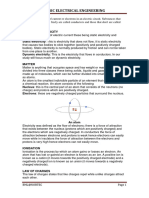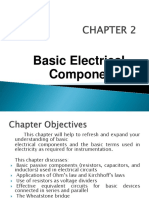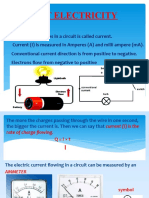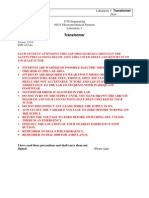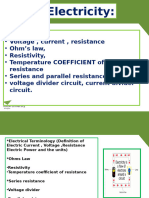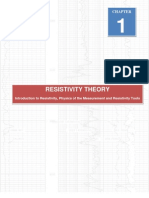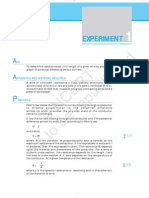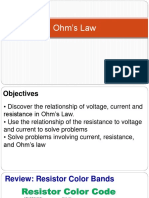JA303 Chapter 1
JA303 Chapter 1
Uploaded by
Muhammad ThalhaCopyright:
Available Formats
JA303 Chapter 1
JA303 Chapter 1
Uploaded by
Muhammad ThalhaOriginal Description:
Copyright
Available Formats
Share this document
Did you find this document useful?
Is this content inappropriate?
Copyright:
Available Formats
JA303 Chapter 1
JA303 Chapter 1
Uploaded by
Muhammad ThalhaCopyright:
Available Formats
JA303 AUTOMOTIVE ELECTRICAL CHAPTER 1
psmza/irwan
INTRODUCTION TO ELECTRIC CIRCUIT
1.1 DEFINITION OF ELECTRIC QUANTITIES
a) Electromotive Force (EMF)
Force or electric pressure causes the flow of electric charge. Source
of electric energy is battery and power plant.
Symbol : E
Unit : Volt (V)
b) Electric charge
Consist of positive and negative charge. Charge quantity is
Coulomb.
Symbol : Q
Unit : Coulomb(C)
c) Current
The movement of electric charge causes by the movement of free
electrons. Current moves from positive to negative terminal
Symbol : I
Unit : Ampere (A)
d) Voltage
The potential difference between two points in an electric circuit.
Symbol : V
Unit : Volt (V)
e) Resistance
The property opposes the movement of current.
Symbol : R
Unit : Ohm ()
1.1.1 Factors that affect the resistance of conductor material:
a) Material (Resistivity)
It is a conductor where it opposes or reduces flow of current
through it.
Symbol : (rho)
Unit : Ohm meter (m)
JA303 AUTOMOTIVE ELECTRICAL CHAPTER 1
psmza/irwan
Resistance is directly proportional to resistivity.
R
b) Length
The resistance will increase when the wire length is increase.
Resistance is directly proportional to length.
R
c) Cross-sectional area.
Resistance is inversely proportional to cross-sectional area.
A
R
1
d) Temperature
Temperature also affects the value of resistance.
Higher value of temperature, the resistance will be higher
T R
From the above relationship between resistance with length, cross-sectional area and the
resistivity, the derived formula is:
A
R
=
Where , R = Resictance ()
= Resistivity, (m)
l = Length , (m)
A = Area, (m
2
)
JA303 AUTOMOTIVE ELECTRICAL CHAPTER 1
psmza/irwan
Example 1.1
Calculate resistance of aluminium cable which has length of 1.5 km. Given that the diameter for the
wire is 10 mm and resistivity is 0.025 O.m.
Solution:
Given, m x d
3
10 10
= , m x
3
10 5 . 1 = , m x O =
6
10 025 . 0
Equation,
A
R
= ,
where
2 6 2
3
2
10 54 . 78 )
2
10 10
( )
2
( m x
x d
A
= = = t t
O = =
477 . 0
10 54 . 78
) 10 5 . 1 )( 10 025 . 0 (
6
3 6
x
x x
R
JA303 AUTOMOTIVE ELECTRICAL CHAPTER 1
psmza/irwan
1.2 TYPES OF ELECTRICAL CIRCUIT
Electric circuit is an arrangement of conductor or cable for current flow from
voltage source into electric components. There are 4 types of electric circuit which
are simple circuit, complex circuit, open circuit and short circuit.
a) Simple Circuit
It is also known as basic circuit as shown in figure below. It is close circuit
which allows flow of current perfectly from source to other components and
back to the source. The circuit consists of voltage supply (V), electric current
(I) and resistance (R).
Figure 1 Simple Circuit
b) Complex Circuit
A complex set of electronic components and their interconnections that are
etched or imprinted onto a tiny slice of semiconducting material.
Figure 1.2 Complex circuit
R
I
V
JA303 AUTOMOTIVE ELECTRICAL CHAPTER 1
psmza/irwan
c) Open Circuit
The electric circuit is no source of burden results to no current flow through
the circuit.
Figure 1.3 Open circuit
d) Short Circuit
The connection is short by a conductor with no burden and has no resistance
value. The current flow is big. Commonly, when short circuit occurs, the fuse
will burn.
Figure 1.4 Short circuit
V
V
Short by a cable
JA303 AUTOMOTIVE ELECTRICAL CHAPTER 1
psmza/irwan
Measurement of Voltage, Current and Resistance.
a) Voltmeter
Voltmeter is used to measure the potential different or voltage (V) in a circuit. Place
one pole of voltmeter at one end of resistor and another pole at another end as shown
below.
Figure 1.5 Voltmeter
b) Ammeter
Ammeter is used to measure current (I) in an electric circuit. The ammeter must be
connected in circuit in order to get the reading from ammeter as shown in diagram
below.
Figure 1.6 Ammeter
V
JA303 AUTOMOTIVE ELECTRICAL CHAPTER 1
psmza/irwan
c) Ohmmeter
Ohmmeter is used to measure the resistance in a circuit. Place ohmmeter according to
the diagram below.
Figure 1.7 Ohmmeter
JA303 AUTOMOTIVE ELECTRICAL CHAPTER 1
psmza/irwan
1.3 OHMS LAW
Ohms Law states that current in complete circuit is directly proportional to pressure or
voltage but inversely proportional to resistance. If the resistance value is remained but the
voltage increase, the current also will increase. Equation for Ohms Law is :
Where, I = Current (A)
V = Voltage (V)
R = Resistance( O )
Linear and Non Linear Resistance
From the exaperiment, relationship between current and voltage is explain in the graph below
where resistance and temperature is keep constant.
V (volt)
R (pemalar)
I (Ampere)
Figure 1.8: V vs I Graph (R constant)
From experiment with vary of resistance, graph is shown below
V
I
Figure 1.9: V vs I Graph (R not constant)
IR V =
JA303 AUTOMOTIVE ELECTRICAL CHAPTER 1
psmza/irwan
Example 1.2
Calculate current when resistance is 10 dan voltage supply is 15V. Then, calculate current when
resistance change to 10 kO.
Penyelesaian :
Given , V= 15V
i). For R = 10,
Ohms Law, V= IR
A
R
V
I 5 . 1
10
15
= = =
ii). For R = 10kO,
mA A x
x R
V
I 5 . 1 10 5 . 1
10 10
15
3
3
= = = =
Practice makes perfect.
Do many exercise to keep
you master the topic
JA303 AUTOMOTIVE ELECTRICAL CHAPTER 1
psmza/irwan
1.4 ELECTRIC POWER
Electric power is a work done in a time. Equation below shows the relation between
powe, current and voltage.
Symbol: P
Unit : Watt (W)
From Ohms law, IR V = dan
R
V
I = ,
R I P
2
=
R
V
P
2
=
IV P =
Where P = Power (W),
I = Current (A)
R = Resistance (O) dan
V = Voltage (V)
JA303 AUTOMOTIVE ELECTRICAL CHAPTER 1
psmza/irwan
THE USE OF WATT METER
Watt meter is used to measure power consumption. There has two coils inside it
where voltage coil is connected in parallel and current coil is conneted in series for an
electric circuit. Watt meter symbol and connectiod are shown below.
Figure 1.10 : Watt meter symbol
Gelung arus
Gelung voltan
Beban (R)
Figure 1.11 : Watt meter connection
W
V
S
Info
Electric power converts to horse power:
1 horse power = 746 watt
JA303 AUTOMOTIVE ELECTRICAL CHAPTER 1
psmza/irwan
Example 1.3
A toaster has current of 5A and home voltage supply is 240V. Calculate the power consumption
needed for the toaster.
Given I = 5 A , V = 240V
Solution
W IV P 1200 ) 240 )( 5 ( = = =
JA303 AUTOMOTIVE ELECTRICAL CHAPTER 1
psmza/irwan
1.5A SERIES CIRCUIT
It is called as series cicuit because of the resistor connection in the circuit. Series
connection is a connection of resistor is in line from end to end as shown in diagram
below.
I
T
Figure 1.12 Series Circuit Connection
From the arrangement of the circuit above, equations are derived with involvement of
total resistance, current and total volatge.
Total Resistance, R
T
Total resistance is the sum of all resistors in the series circuit (1.5a).
(1.5a)
Total Current, I
T
Current through in every resistor is same as given in equation (1.5b).
(1.5b)
n T
R R R R R + + + + = .....
3 2 1
n T
I I I I I = = = = = ......
2 2 1
n j
I I I I I = = = = = ......
2 2 1
R
1
R
3
R
n
R
2
+ V
1
- + V
2
- + V
3
-
+
V
n
-
V
T
JA303 AUTOMOTIVE ELECTRICAL CHAPTER 1
psmza/irwan
Total Voltage, V
T
Total voltage is the sum of all voltage reduction on every resistor as described in
equation (1.5c).
(1.5c)
While the reduction in every resistor can be calculated using Ohms Law as we
mentioned before. Equation (1.5d) below shows the method to calculate the voltage
reduction..
n T n
T
T
T
R I V
R I V
R I V
R I V
=
=
=
=
3 3
2 2
1 1
Voltage Divider Rule
We can use volatge divider rule in order to calculate the value of individual voltage
through every resistor in series circuit as described in equation(1.5e) and (1.5f).
i). For circuit has 3 resistors :
T
V
R R R
R
V ) (
3 2 1
1
1
+ +
=
T
V
R R R
R
V ) (
3 2 1
2
2
+ +
=
(1.5e)
T
V
R R R
R
V ) (
3 2 1
3
3
+ +
=
ii). For circuit has 2 resistors:
T
V
R R
R
V ) (
2 1
1
1
+
=
T
V
R R
R
V ) (
2 1
2
2
+
=
n T
V V V V V + + + + = ......
3 2 1
(1.5d)
(1.5f)
JA303 AUTOMOTIVE ELECTRICAL CHAPTER 1
psmza/irwan
Exercise
From the diagram, determine ;
i). Total resistance, R
T
ii). Circuit current, I
T
iii). Voltage reduction in every resistor.
Solution
i). Total resistance, R
T
R
T
= R
1
+ R
2
= (15 + 10) = 25 O
ii). Circuit current, I
T
I
T
=
T
R
V
=
25
120
= 4.8 A
iii) Voltage reduction in every resistor
V
R1
= I
T
R
1
= (4.8)(15) = 72 V
V
R2
= I
T
R
2
= (4.8)(10) = 48 V
R
1
=15
R
2
=10
V=120V
JA303 AUTOMOTIVE ELECTRICAL CHAPTER 1
psmza/irwan
1.5 B PARALLEL CIRCUIT
Parallel connection is shown in figure below.
Figure 1.13 Parallel Circuit
Total Voltage, V
T
Voltage across every junction is the same value of voltage supply as given in
equation(1.5g);
(2.7)
Total Current, I
T
Total current is value of current supply or the summation of junction currents (1.5h);
n T
V V V V V = = = = = ......
2 2 1
n j
I I I I I = = = = = ......
2 2 1
n T
I I I I I + + + + = .....
3 2 1
(1.5h)
V
T
I
T
I
1
I
2
I
3
R
1
R
2
R
3
V
1
V
2
V
3
(1.5g)
JA303 AUTOMOTIVE ELECTRICAL CHAPTER 1
psmza/irwan
Total Resistance, R
T
In parallel circuit, resistance is calculated using equation (1.5i);
For a circuit has 3 resistors;
3 2 1
1 1 1 1
R R R R
T
+ + =
atau
3 1 3 2 2 1
3 2 1
R R R R R R
R R R
R
T
+ +
=
Current Divider Rule
We can use Current Divider Rule for determine current value in every junction in
circuit (1.5j).
i). For circuit has 2 resistors
Figure 1.14
T
I
R R
R
I ) (
2 1
2
1
+
=
T
I
R R
R
I ) (
2 1
1
2
+
=
(1.5i)
(1.5j)
V
T
I
T
I
1
I
2
R
1
V
1
R
2
V
2
You might also like
- Wa0002Document164 pagesWa0002wilson simfukweNo ratings yet
- Lab Report For Circuit TheoryDocument28 pagesLab Report For Circuit TheoryMuthmain YusofNo ratings yet
- ElectricityDocument14 pagesElectricityTECH RISERNo ratings yet
- Sy4003fp Chapter 1 Rev3Document6 pagesSy4003fp Chapter 1 Rev3junel pradoNo ratings yet
- Unit IDocument50 pagesUnit IThiaga RajanNo ratings yet
- Power in DC Circuits: Power, Series/Parallel Resistive Circuit, Dissipates, DC Fundamentals Circuit Board, MultimeterDocument3 pagesPower in DC Circuits: Power, Series/Parallel Resistive Circuit, Dissipates, DC Fundamentals Circuit Board, Multimeterjeremias marticioNo ratings yet
- Lecture 1_Part1Document14 pagesLecture 1_Part1SILENT KILLER GAMINGNo ratings yet
- Building Services Book 2Document237 pagesBuilding Services Book 2Africana RoyalNo ratings yet
- Building-Electric-Circuits-Activity-Science-Presentation-in-Light-Green-Blue-Colorful-StyleDocument27 pagesBuilding-Electric-Circuits-Activity-Science-Presentation-in-Light-Green-Blue-Colorful-StyleednaligjenelynNo ratings yet
- Units of ElectricityDocument36 pagesUnits of ElectricityMSM7865No ratings yet
- Electricity: Made By:-Tushar Bhutani X - ADocument36 pagesElectricity: Made By:-Tushar Bhutani X - ATushar BhutaniNo ratings yet
- Chapter 1 - Introduction To Electrical CircuitsDocument75 pagesChapter 1 - Introduction To Electrical CircuitsabuwakapNo ratings yet
- Electrical Circuit Lab1Document44 pagesElectrical Circuit Lab1rahmahamjad90No ratings yet
- DC Component AnalysisDocument9 pagesDC Component Analysisvivianzhu120No ratings yet
- Chapter 2 DC Circuit TheoryDocument37 pagesChapter 2 DC Circuit TheoryTynoh MusukuNo ratings yet
- Provided by Pn. Zuraidah BT Ali Mech. Eng. Dept. PUODocument53 pagesProvided by Pn. Zuraidah BT Ali Mech. Eng. Dept. PUOMuhd AkmalNo ratings yet
- L-12 Electricity-NotesDocument6 pagesL-12 Electricity-NotesdaansaiieNo ratings yet
- Introduction To Electric CircuitDocument81 pagesIntroduction To Electric Circuitkaushallyaa navindranNo ratings yet
- Basic Electricity - NortecDocument218 pagesBasic Electricity - NortecpoyamulengaNo ratings yet
- Electricity and Circuits Conceptual PhysicsDocument8 pagesElectricity and Circuits Conceptual PhysicsQuinto Jaypee SeinseiNo ratings yet
- TOPIC 11.2 & 11.3 CURRENT ELECTRICITY & PRIMARY AND SECONDARY CELLS RoySci Notes 2021Document21 pagesTOPIC 11.2 & 11.3 CURRENT ELECTRICITY & PRIMARY AND SECONDARY CELLS RoySci Notes 2021marthasithole78No ratings yet
- Current Electricity O LevelDocument59 pagesCurrent Electricity O LevelNoah OkitoiNo ratings yet
- Shell Electrical Engineer HandbookDocument16 pagesShell Electrical Engineer Handbookimemyself009100% (1)
- Chapter L: Introduction To Electrical CircuitsDocument27 pagesChapter L: Introduction To Electrical CircuitsM. Umair WaheedNo ratings yet
- Utl 313 - Module-1 - 2425. MGR (Student Copy)Document61 pagesUtl 313 - Module-1 - 2425. MGR (Student Copy)simbulan.krizielleannNo ratings yet
- EPCE2101 Chapter - 2 Handout NewDocument41 pagesEPCE2101 Chapter - 2 Handout Newdagimnega44No ratings yet
- 5.1: Electrical DistributionDocument31 pages5.1: Electrical DistributionShuhada SamsudinNo ratings yet
- CH 3 - Basics of Electrical CircuitsDocument80 pagesCH 3 - Basics of Electrical CircuitsnazxalafNo ratings yet
- EDC Lab 1Document13 pagesEDC Lab 1Xrein MarkNo ratings yet
- Basic Electrical EngineeringDocument213 pagesBasic Electrical EngineeringchaliebainnocentNo ratings yet
- Physics (5054) For Grade 11: Chapter 19: "Current Electricity"Document45 pagesPhysics (5054) For Grade 11: Chapter 19: "Current Electricity"Hammad AhmedNo ratings yet
- Lecture 2-bDocument28 pagesLecture 2-bEslam SarwatNo ratings yet
- SSS 1 3RD TermDocument21 pagesSSS 1 3RD TermabiodunokoyaNo ratings yet
- Basic Electrical Engineering Lab ManualDocument34 pagesBasic Electrical Engineering Lab ManualAmulyaNo ratings yet
- CHAPTER 2 (Autosaved)Document76 pagesCHAPTER 2 (Autosaved)dray09100% (1)
- Electronic Circuit - AnalysisDocument12 pagesElectronic Circuit - AnalysisThivhulawi MukondeleliNo ratings yet
- Electrical Circuits Part 1 - Lecture PDFDocument34 pagesElectrical Circuits Part 1 - Lecture PDFRyan Cortes0% (1)
- Electrical Components and Circuits Not MineDocument21 pagesElectrical Components and Circuits Not MineMark Cliffton BadlonNo ratings yet
- Unit 3.2. Technology - Electricity. Electrical QuantitiesDocument11 pagesUnit 3.2. Technology - Electricity. Electrical QuantitiesGuillem Rubio DufourgNo ratings yet
- Electric Circuits Analysis 1 - With Page NumbersDocument15 pagesElectric Circuits Analysis 1 - With Page Numberskenneth1195No ratings yet
- w2 BasicsDocument26 pagesw2 Basicsmurat aydoganNo ratings yet
- Activity No. 3 Resistive Circuit Objectives: Sin ɷtDocument3 pagesActivity No. 3 Resistive Circuit Objectives: Sin ɷtJohn Paul BaquiranNo ratings yet
- Practical No. 6:: Practical To Verify The Ohm's LawDocument4 pagesPractical No. 6:: Practical To Verify The Ohm's Lawعبدالمقیت مرزاNo ratings yet
- Currrent Electricity FinalDocument30 pagesCurrrent Electricity FinalSaadullah Shahid100% (1)
- Electricity Class 10 Notes for Quick RevisionDocument9 pagesElectricity Class 10 Notes for Quick Revisiongargeechaudhari96No ratings yet
- ElectricityDocument15 pagesElectricityapi-246793885No ratings yet
- Chapter 2: DC Circuit TheoryDocument37 pagesChapter 2: DC Circuit TheoryTaonga Nhambi100% (1)
- Bjte2023 WK02Document36 pagesBjte2023 WK02Hafiz khalidNo ratings yet
- BEE Lecture 14-15Document31 pagesBEE Lecture 14-15Jasmine HansdaNo ratings yet
- Principal Mwalusi Basic Electrical EngineeringDocument216 pagesPrincipal Mwalusi Basic Electrical EngineeringVictor mulotaNo ratings yet
- ElectricityDocument4 pagesElectricityaaravvasdev34No ratings yet
- Electricity Notes For CBSE Class 10 PhysicsDocument5 pagesElectricity Notes For CBSE Class 10 Physicssadiyaarchive22No ratings yet
- Electricity - NotesDocument5 pagesElectricity - NotesSamten LepchaNo ratings yet
- 11.3-4 CURRENT ELECTRICITY My Notes (Repaired)Document30 pages11.3-4 CURRENT ELECTRICITY My Notes (Repaired)lotsithole6No ratings yet
- Ohm's LawDocument10 pagesOhm's LawGrae GonzagaNo ratings yet
- EMS Lab3 - 2 - 04Document15 pagesEMS Lab3 - 2 - 04Jegan PrasadNo ratings yet
- Beeme Unit IDocument258 pagesBeeme Unit IGenga DeviNo ratings yet
- Part 2 Basic ElectricityDocument40 pagesPart 2 Basic ElectricityBasser BAUTINGNo ratings yet
- Example of Lab ReportDocument6 pagesExample of Lab ReportRomi Necq S. AbuelNo ratings yet
- CHAPTERWISE-EXAMINATIONS QUESTION II PUC (2014 TO 2024) SunilDocument24 pagesCHAPTERWISE-EXAMINATIONS QUESTION II PUC (2014 TO 2024) Sunilpedonika.tanked1No ratings yet
- Introductory Circuit Analysis, 13th Edition (eBook PDF) 2024 scribd downloadDocument51 pagesIntroductory Circuit Analysis, 13th Edition (eBook PDF) 2024 scribd downloadafkomwambu100% (2)
- Criterion CDocument5 pagesCriterion CLuke SmithNo ratings yet
- Compilation of Lab Activity No. 6Document113 pagesCompilation of Lab Activity No. 6Anthony CortezNo ratings yet
- 2 - Current Electricity PDFDocument27 pages2 - Current Electricity PDFthinkiitNo ratings yet
- Chapter - 18 Current ElectricityDocument48 pagesChapter - 18 Current Electricityashiq3pNo ratings yet
- Home - General Resources Eddy Current Inspection Formula: Ohm's Law Impedance Phase Angle Magnetic PermeabilityDocument4 pagesHome - General Resources Eddy Current Inspection Formula: Ohm's Law Impedance Phase Angle Magnetic PermeabilityJawad MunirNo ratings yet
- BEE U1 (DC Network)Document34 pagesBEE U1 (DC Network)dabriyadNo ratings yet
- Project Report Sample FileDocument79 pagesProject Report Sample FileAbhishekNo ratings yet
- (Electrical Circuits 1) SyllabusDocument2 pages(Electrical Circuits 1) SyllabusDarwinVillanueva50% (2)
- 01 Resistivity TheoryDocument64 pages01 Resistivity Theorydibakar_04100% (1)
- 12 Eng Physics Lab ManualDocument89 pages12 Eng Physics Lab Manuald838282No ratings yet
- Resistor WikipediaDocument18 pagesResistor Wikipediaprabhakaran_hdecNo ratings yet
- +2 Physics English MediumDocument73 pages+2 Physics English MediumSURESH PANDI67% (3)
- Lecture 1 - Introduction To ElectricityDocument15 pagesLecture 1 - Introduction To ElectricityjohnrafaeltrementizoNo ratings yet
- COM 223 Lecture Note 1Document10 pagesCOM 223 Lecture Note 1ejenakevwesamuel954No ratings yet
- Electricity Chapter Wise Important Questions Class 10 ScienceDocument3 pagesElectricity Chapter Wise Important Questions Class 10 Scienceshashank srivastavaNo ratings yet
- 27C1024 - EpromDocument20 pages27C1024 - EpromSavo BacicNo ratings yet
- Part Simulation, Constant Voltage and Current ReportDocument4 pagesPart Simulation, Constant Voltage and Current Reportميسرة100% (1)
- Set A - Tle - ExamDocument8 pagesSet A - Tle - ExamMark Anthony LibecoNo ratings yet
- Report Lab 1Document15 pagesReport Lab 1Mohd Syamsul Ramli100% (1)
- Ohms Law Series and Parallel CktsDocument43 pagesOhms Law Series and Parallel CktsKim OpenaNo ratings yet
- Electricity and MagnetismDocument22 pagesElectricity and Magnetismkhrisannmiller12No ratings yet
- Electricity - Part 1Document9 pagesElectricity - Part 1Saji JayarajNo ratings yet
- Electrical Performance: 2.1 Thermodynamics Inside A BatteryDocument26 pagesElectrical Performance: 2.1 Thermodynamics Inside A BatteryTarek HmroucheNo ratings yet
- Ohm's LawDocument2 pagesOhm's Lawadwaiths2629No ratings yet
- Material - ρ - - σ -: Resistivity Coefficient Temperature Coefficient ConductivityDocument9 pagesMaterial - ρ - - σ -: Resistivity Coefficient Temperature Coefficient ConductivityJoshua JacksonNo ratings yet
- O-Level Physics - Current ElectricityDocument2 pagesO-Level Physics - Current ElectricityGolam Hasib100% (1)
- Basic Electro-Mechanical Engineering (EE-170) : Lecture#02Document41 pagesBasic Electro-Mechanical Engineering (EE-170) : Lecture#02Hassnain MassidNo ratings yet
